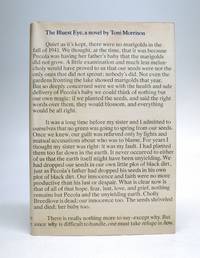

How many pages is the bluest eye how to#
Therefore, systemic racism takes one form in “The Bluest Eye” through Polly and Pecola’s …show more content… As Pecola ends up descending into madness by the end of the book and her story, many of the factors that hurt her were results of systemic racism as she was unable to be comfortable in her own skin since she was a black girl and not as “pretty” as Shirley Temple or Maureen Peal, and when she ended up pregnant and taken out of school, she was too blind by her wish for blue eyes and her promise by the interracial “Soaphead Church” to properly realize what was going on and how to properly recover from it. The novel describes her wish by saying that “It had occurred to Pecola some time ago that if her eyes, those eyes that held the pictures.were different, that is to say, beautiful, she herself would would be different.Each night, without fail, she prayed for blue eyes.” (Morrison, page 46) At a later point in the book, Polly claims that “The onliest time I be happy seem like when I was in the picture show.I ‘member one time I went to see Clark Gable and Jean Harlow.I fixed my hair up like I’d seen hers on a magazine…I sat in that show with my hair done up that way and had a good time.” (Morrison, page 123) By repeatedly exposing herself to those films portraying white glamour and standards, Polly is effectively allowing herself to live a fantasy she will never have, and end up believing that the pro-white standards shown in these movies are more ideal than the life she had been living. 5) Although Feagin first coined the term, the idea of …show more content… All through the story of the novel, the protagonist Pecola Breedlove, wishes to have the blue eyes of a white girl so that she can finally be seen as beautiful and valuable, this of course based on a standard made by systemic racism. One type of racism is systemic racism, which is defined by professor John Feagin as “a diverse assortment of racist practices the unjustly gained economic and political power of whites the continuing resource inequalities and the white-racist ideologies, attitudes, and institutions created to preserve white advantages and power.” (, p. Racism used to be, and still may be, extremely commonplace, and can take many different forms or fit into many different categories.


Show More In modern America, people often look at racism with a negative connotation and question the reason for its existence, but forget that for a long period of time, being racist was part of everyday life.


 0 kommentar(er)
0 kommentar(er)
